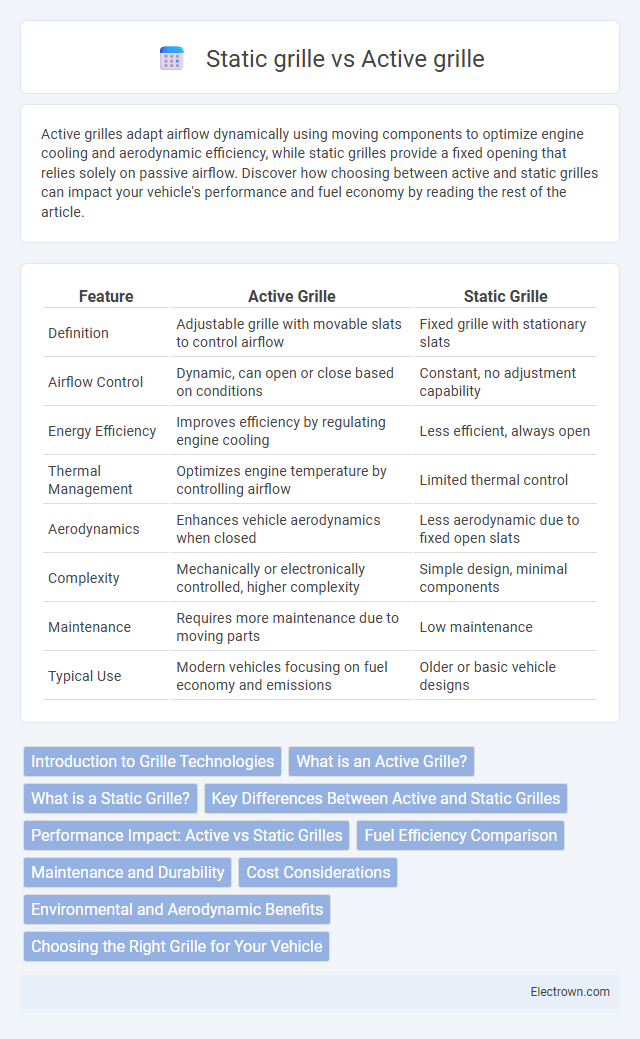Active grilles adapt airflow dynamically using moving components to optimize engine cooling and aerodynamic efficiency, while static grilles provide a fixed opening that relies solely on passive airflow. Discover how choosing between active and static grilles can impact your vehicle's performance and fuel economy by reading the rest of the article.
Table of Comparison
| Feature | Active Grille | Static Grille |
|---|---|---|
| Definition | Adjustable grille with movable slats to control airflow | Fixed grille with stationary slats |
| Airflow Control | Dynamic, can open or close based on conditions | Constant, no adjustment capability |
| Energy Efficiency | Improves efficiency by regulating engine cooling | Less efficient, always open |
| Thermal Management | Optimizes engine temperature by controlling airflow | Limited thermal control |
| Aerodynamics | Enhances vehicle aerodynamics when closed | Less aerodynamic due to fixed open slats |
| Complexity | Mechanically or electronically controlled, higher complexity | Simple design, minimal components |
| Maintenance | Requires more maintenance due to moving parts | Low maintenance |
| Typical Use | Modern vehicles focusing on fuel economy and emissions | Older or basic vehicle designs |
Introduction to Grille Technologies
Active grille technology integrates adjustable louvers or vents controlled electronically to optimize airflow and thermal management in automotive or HVAC systems, enhancing energy efficiency and occupant comfort. Static grilles consist of fixed, non-movable components designed primarily for protection and airflow without dynamic adjustment capabilities, commonly found in traditional vehicle front-end designs. The choice between active and static grilles impacts aerodynamic performance, fuel economy, and system responsiveness in temperature regulation.
What is an Active Grille?
An active grille is a high-performance cooling component in vehicles that uses electronically controlled louvers to regulate airflow dynamically based on engine temperature and driving conditions. Unlike static grilles, which have fixed openings, active grilles open or close automatically to optimize aerodynamic efficiency and enhance fuel economy. Your vehicle benefits from reduced drag and improved engine cooling, contributing to overall performance and emission control.
What is a Static Grille?
A static grille is a fixed, non-moving ventilation or speaker cover designed to allow airflow or sound passage while maintaining a permanent position. Unlike active grilles, which adjust to control flow or acoustics dynamically, static grilles provide consistent and uninterrupted airflow without mechanical parts. Your choice of a static grille ensures durability and minimal maintenance in HVAC systems or audio setups.
Key Differences Between Active and Static Grilles
Active grilles feature adjustable louvers controlled by sensors or motors to optimize airflow and improve fuel efficiency, whereas static grilles have fixed openings that provide constant ventilation without airflow modulation. Active grilles can automatically open or close based on engine temperature or vehicle speed, enhancing aerodynamic performance and reducing drag, while static grilles prioritize simplicity and durability. Understanding these differences helps you choose the right grille type for balancing cooling needs and aerodynamic efficiency in your vehicle.
Performance Impact: Active vs Static Grilles
Active grilles dynamically adjust airflow to optimize engine cooling and improve aerodynamic efficiency, resulting in enhanced fuel economy and reduced emissions compared to static grilles that remain fixed. Performance gains from active grilles include better temperature regulation during varying driving conditions, which supports engine longevity and power output. Your vehicle benefits from these advancements by maintaining optimal performance while minimizing drag and energy consumption.
Fuel Efficiency Comparison
Active grilles improve fuel efficiency by dynamically adjusting airflow to reduce drag, allowing your vehicle to use less energy during highway driving. Static grilles remain fixed, causing constant aerodynamic resistance that can increase fuel consumption. Choosing an active grille system can significantly enhance your car's fuel economy, especially at higher speeds.
Maintenance and Durability
Active grilles require regular maintenance due to moving parts that may wear out or malfunction over time, while static grilles offer greater durability with fewer mechanical components to service. Static grilles are typically made from corrosion-resistant materials, reducing the need for frequent repairs and extending their lifespan. You can expect lower long-term maintenance costs with static grilles, but active grilles provide enhanced functionality that may justify periodic upkeep.
Cost Considerations
Active grilles typically have higher initial costs due to complex components like motors and sensors essential for dynamic airflow control, whereas static grilles are more affordable with simpler designs and fewer parts. Maintenance expenses for active grilles can rise because of electronic controls that may require regular servicing or replacements, contrasting with the low upkeep costs of static grilles. Budget-conscious projects often favor static grilles for cost efficiency, while active grilles are chosen for applications where performance benefits justify the higher investment.
Environmental and Aerodynamic Benefits
Active grilles enhance vehicle aerodynamics by dynamically adjusting airflow, reducing drag and improving fuel efficiency compared to static grilles that remain fixed. This adaptive airflow management helps lower carbon emissions by optimizing engine cooling only when necessary, contributing to environmental sustainability. Vehicles equipped with active grilles achieve better aerodynamic performance, resulting in reduced energy consumption and a smaller environmental footprint.
Choosing the Right Grille for Your Vehicle
Choosing the right grille for your vehicle involves understanding the differences between active and static grilles to optimize performance and aesthetics. Active grilles feature adjustable louvers that improve aerodynamics and engine cooling by opening and closing based on temperature needs, enhancing fuel efficiency and reducing emissions. Static grilles, while less technologically advanced, provide durability and a consistent design appearance, making them a reliable choice for maintaining your vehicle's style without added mechanical complexity.
Active grille vs Static grille Infographic

 electrown.com
electrown.com